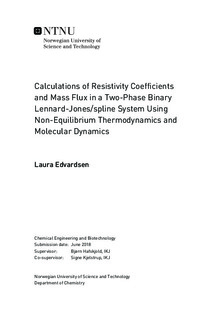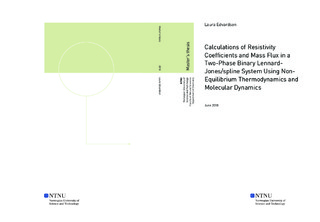| dc.description.abstract | Fresh water has a vital role in our everyday life. However, it is also increasingly scarce and it is important to obtain better understanding of water purification processes to secure global access to clean water. There exist many processes for water purification. In this study, the purification process membrane distillation was investigated. The aim of this study was to use non-equilibrium thermodynamics to create a model to find the resistivity coefficients present due to a thermal and chemical potential driving force. These coefficients can provide accurate information about the mass transport through the membrane. A two-phase system containing two different Lennard-Jones/spline fluids, pure liquid and mixture, separated by a hydrophobic pore was modelled to calculate these coefficients. Lennard-Jones/spline particles were used to simplify the system.
It was first constructed a simple two-component system to find optimal conditions for the mixture in the pore system. For this simple system, a phase diagram was created. Then, four different systems were constructed to find the total and local resistivity coefficients. The total resistivity coefficients were rqq=13+-3, rqu=-20+-2 and ruu=35+-2. The local resistivity coefficients include the coefficients for the surface between mixture and vapor (r(s,l)), the vapor coefficient (r(vapor)), and for the surface between vapor and pure liquid (r(s,r)). These were found to be rqq(s,l)=23+-2, rqu(s,l)=-15+-1, ruu(s,l)=11+-2, rqq(vapor)=7+-1, rqu(vapor)=-0.5+-0.7, ruu(vapor)=0.05+-0.04 and rqq(s,r)=13.6+-0.8, rqu(s,r)=-8+-2, ruu(s,r)=13+-1. It was seen that the surfaces had resistivity coefficients that were significantly different from the bulk coefficients. This indicate that surface resistivity coefficients have a crucial role when it comes to providing accurate information regarding the mass flux.
Simulations were also conducted to investigate how mass transport was influenced by temperature and pore diameter. A linear correlation between temperature and mass flux was found, where the mass flux increased with increasing temperature gradient. The greatest mass flux was obtained for the smallest pore investigated (pore diameter equal 10 molecular diameters). This result implied that a membrane with a greater number of pores with diameter 10 molecular diameters would provide a greater mass transport compared to a membrane with fewer, larger pores. | |

